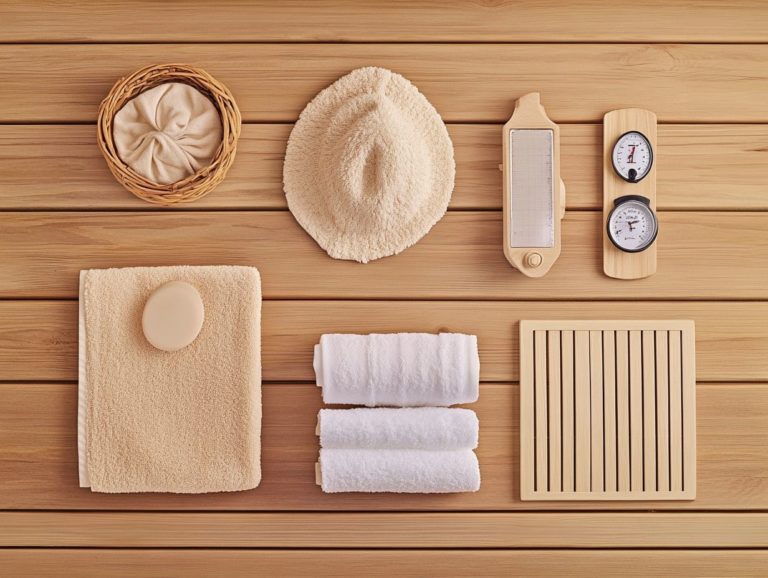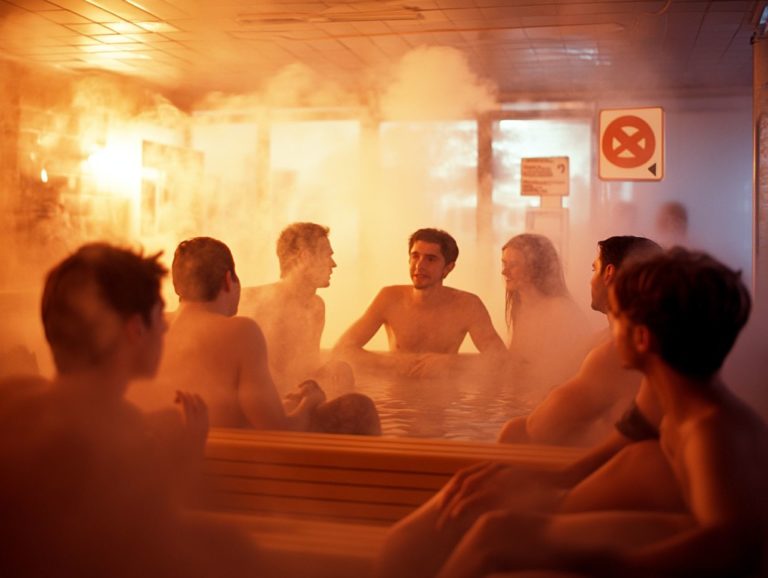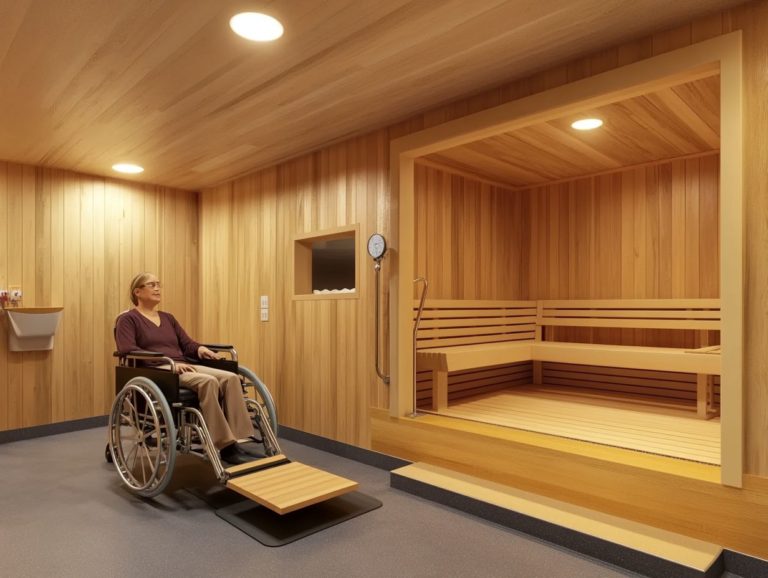Sauna Safety Protocols for Group Sessions
Sauna sessions, especially in an infrared sauna, can provide you with a relaxing and rejuvenating experience, particularly when enjoyed in the company of friends.
However, ensuring safety during these group sessions is paramount to prevent any potential health risks, especially concerning sauna use. This article delves into essential precautions you should consider, from assessing your health to understanding sauna protocols, maintaining proper equipment, and staying hydrated.
It also highlights safety tips specifically designed for group environments, including recommended limits, emergency procedures, and proper sauna etiquette. By prioritizing safety, especially regarding hydration levels and health guidelines, you can fully embrace the numerous benefits of sauna use without any concerns lingering in the back of your mind.
Contents
- Key Takeaways:
- Precautions Before Using a Sauna
- Sauna Safety Protocols
- Safety Tips for Group Sauna Sessions
- Potential Risks and How to Address Them
- Frequently Asked Questions
- What are the recommended safety protocols for group sauna sessions?
- Are there any specific guidelines for using a sauna with a group?
- Is it safe for pregnant women to participate in group sauna sessions?
- What is the recommended age for participating in group sauna sessions?
- How can I ensure proper hygiene during a group sauna session?
- What should I do if I start feeling dizzy or unwell during a group sauna session?
Key Takeaways:

Why Safety is Important in Group Sauna Sessions
Safety should be at the forefront during group sauna sessions. It ensures your well-being and fosters a harmonious atmosphere for everyone involved. This is particularly critical for those with conditions like multiple sclerosis and adrenal suppression.
By adhering to health guidelines and proper sauna etiquette, you can unlock the therapeutic benefits of infrared sauna therapy while minimizing potential health risks associated with conditions such as diabetes and high blood pressure.
A collective understanding of hydration, body temperature management, and personal health considerations, including avoiding alcohol, can elevate your sauna experience. This allows you to enjoy the relaxation room while keeping risks at bay.
Prioritizing hydration, including replenishing electrolytes, is key. It significantly reduces the chances of dehydration and heat-related illnesses, which are crucial factors in a communal setting.
By following safety protocols, especially those involving hydration and monitoring blood circulation, you take care of your health and contribute to a culture of care within the group. For more insights, check out sauna safety: the role of community awareness. Relaxation rooms serve as essential sanctuaries for recovery, providing a tranquil space to unwind after sauna use, particularly beneficial for clients reporting muscle soreness and cardiovascular improvement.
Incorporating infrared saunas, which utilize light energy for deeper tissue relaxation, further amplifies these benefits. This approach offers deeper tissue relaxation while potentially easing muscle soreness and improving circulation.
This holistic approach to sauna therapy nurtures a shared commitment to well-being, enabling everyone to fully appreciate the myriad health advantages on offer, including enhanced detoxification and better health.
Precautions Before Using a Sauna
Before stepping into a sauna, especially an electric heated one, it s essential to familiarize yourself with the safety precautions that will enhance your experience and ensure your well-being. Pay attention to your hydration levels, particularly when considering health risks like those associated with prescription drugs.
Understanding health risks for sauna use such as specific medical conditions like hemophilia, diabetes, or pregnancy that might require consultation allows you to approach this wellness therapy with confidence and clarity. This maximizes its benefits for your health.
Ready to relax? Let’s explore how to make your sauna experience safe and enjoyable!
Assessing Personal Health and Risks
Assessing your personal health and any associated risks is crucial when considering sauna use, especially if you have conditions like multiple sclerosis, adrenal suppression, or if you re on prescription medications and have artificial implants. Understanding your health profile gives you the power to make informed choices that optimize the benefits of sauna bathing while avoiding potential health risks.
To evaluate your health status, consulting healthcare professionals is essential. They can provide guidance tailored to your unique medical history, particularly regarding medications like anticoagulants.
This step is vital for managing chronic diseases like diabetes and high blood pressure. Certain conditions can change how your body responds to heat.
Being aware of your personal health risks encourages safer sauna practices. These include limiting exposure time, staying hydrated, and avoiding sauna use after consuming alcohol.
Consider potential interactions between your medications and heat exposure, as this can influence how you experience sauna benefits. A clear understanding of your health profile leads to a more enjoyable and safer sauna experience.
Sauna Safety Protocols
Implementing proper sauna safety protocols is essential for a safe and enjoyable experience for every user. This is especially important for young children and pregnant women. Grasping the sauna rules and guidelines is crucial, including those regarding hydration and temperature limits.
Key elements to consider are monitoring your body temperature, staying adequately hydrated, and familiarizing yourself with the sauna facilities and equipment.
- Monitor your body temperature
- Stay hydrated
- Familiarize yourself with the facilities
These practices enhance your overall sauna experience, allowing you to embrace the relaxation and benefits it offers while promoting improved circulation and detoxification.
Proper Use and Maintenance of Sauna Equipment

Proper use and maintenance of sauna equipment are vital for ensuring your safety and the longevity of the unit, especially with electric heated saunas that boast advanced energy efficiency. Understanding how to effectively utilize sauna facilities, including proper hydration practices, can elevate your experience while minimizing risks related to equipment malfunction.
Routine checks on the heater, temperature controls, and safety features are essential to prevent safety-compromising issues. Familiarizing yourself with the user interface allows you to navigate settings easily, ensuring smooth operation.
Regularly inspecting the heating elements and wooden structures helps identify wear and tear before they escalate into major problems. Maintaining optimal energy efficiency not only lowers operational costs but also enhances the sauna s performance, allowing you to enjoy the health benefits of sauna therapy without unnecessary risks.
Monitoring Body Temperature and Hydration
Monitoring your body temperature and hydration levels during sauna sessions is crucial for enjoying the therapeutic benefits of sweating therapy while ensuring your safety. Engaging in sweating therapy can help remove harmful substances from your body, but it s essential to stay hydrated to avoid any adverse effects.
To gauge your body temperature accurately, use a thermometer. This helps keep your temperature within safe limits, usually around 150-195 degrees Fahrenheit. It’s important to prevent heat-related illnesses. Be aware of early signs of overheating, such as dizziness, excessive fatigue, or nausea. If you notice these, step out of the sauna and rehydrate immediately to prevent health risks.
Sweating is a vital part of detoxifying your body, flushing out toxins and impurities through your skin, which helps improve your health. Make it a habit to drink water before, during, and after your sauna sessions. Don’t forget to drink electrolyte-replenishing drinks, especially after extended exposure, to support recovery and hydration.
Snacking on hydrating fruits can further enhance your fluid intake and help with toxin removal. This enriches your sauna experience while supporting your body’s natural processes.
Safety Tips for Group Sauna Sessions
Safety tips for group sauna sessions are essential for enjoying the benefits of infrared saunas while minimizing health risks. Emphasizing sauna etiquette, including the importance of hydration and encouraging open communication among participants, helps create a respectful and safe atmosphere for everyone.
Recommended Group Size and Time Limits
Maintaining recommended group sizes and time limits is essential for ensuring everyone’s comfort and safety, especially for young children and pregnant women. By following these guidelines, you elevate your sauna experience and manage hydration levels and body temperature more effectively, contributing to cardiovascular health.
Smaller groups allow better airflow and personal space, helping prevent overheating and fostering a relaxed atmosphere. When you can enjoy your sauna time without feeling cramped, you’re more likely to experience improved circulation and detoxification.
Limiting session durations is crucial for preventing dehydration. Regular hydration breaks can make a significant difference, allowing everyone to enjoy the experience safely while promoting toxin elimination.
Communication and Emergency Procedures
Effective communication and clear emergency procedures are vital for safety during group sauna sessions, especially considering participants’ unique needs. This approach allows everyone to fully embrace the relaxation and therapeutic benefits that saunas offer.
When everyone knows the protocols in place, including those related to hydration and health risks, it enhances the overall atmosphere and creates a sense of community. This understanding helps reduce anxiety, particularly for those with conditions like adrenal suppression, allowing you to immerse yourself in the soothing warmth of the sauna. For more insights, check out sauna safety and communication.
Knowing how to communicate effectively during a crisis can significantly reduce risks, creating a smoother, more enjoyable sauna experience for everyone. For those interested in further enhancing their understanding, understanding sauna safety legislation is crucial. Prioritizing these practices shows appreciation for the balance between relaxation and safety, enriching your wellness journey.
Potential Risks and How to Address Them

Understanding the potential risks associated with sauna use is crucial for maintaining a safe environment, especially for those with specific health concerns, like bleeding disorders.
Being aware of the symptoms of overheating or fainting allows you to take prompt action, ensuring the safety and well-being of everyone involved. This proactive approach enhances your sauna experience and fosters a healthier atmosphere for all participants. For more information, you can check sauna safety resources to find helpful guidance.
Dealing with Overheating or Fainting
Dealing with overheating or fainting in a sauna requires your immediate attention and a solid understanding of effective responses to safeguard your health. Recognizing the signs of overheating and staying hydrated can significantly reduce these risks, paving the way for a safer sauna experience.
Stay alert! Watch for symptoms like excessive sweating, dizziness, and nausea, as these may indicate your body is struggling to handle high temperatures. Monitoring your body temperature and scheduling regular breaks is vital.
Sipping water consistently helps maintain optimal hydration and can drastically lower your chances of heat-related illnesses. Listen to your body. Know when it s time to step out and cool down. This plays a crucial role in preventing serious health issues associated with prolonged sauna exposure.
Preventing the Spread of Illness
Preventing the spread of illness in sauna settings is essential. These facilities often bring people together in close quarters, heightening the risk of germ transmission. By following sauna etiquette, like being mindful of young children and avoiding alcohol before sessions, you can significantly reduce the likelihood of illness spreading.
Regular handwashing and using wipes that kill germs can elevate hygiene standards in shared spaces. Encourage individuals to bring their own towels and sit on them instead of directly on benches to minimize direct contact with surfaces that might harbor bacteria.
Act now! Staying out of the sauna when you feel unwell is vital for your safety and the safety of others. This simple yet effective measure protects yourself and those around you from potential infections. Embracing a sense of collective responsibility fosters a healthier atmosphere for all patrons.
Frequently Asked Questions
What are the recommended safety protocols for group sauna sessions?
The recommended safety protocols for group sauna sessions include limiting the session to 10-15 minutes, drinking water before and after the session, and avoiding alcohol or drugs beforehand.
Are there any specific guidelines for using a sauna with a group?

Absolutely! Having a sauna leader is key. They ensure everyone follows safety rules and monitors the group’s well-being. The sauna leader should also have basic first aid knowledge and recognize signs of heat exhaustion or dehydration.
Is it safe for pregnant women to participate in group sauna sessions?
No, pregnant women should not use saunas, especially in a group setting. The high heat and elevated heart rate can be harmful to both the mother and the unborn baby.
What is the recommended age for participating in group sauna sessions?
The recommended age for using a sauna in a group setting is 18 and above. Saunas can be physically demanding and may not be safe for children or young adults.
How can I ensure proper hygiene during a group sauna session?
To ensure proper hygiene, use a towel or sauna mat to sit on, wear a clean swimsuit or clothing, and avoid sharing towels or other personal items with others in the sauna.
Take charge of your sauna experience stay safe, stay hydrated, and enjoy every moment!
What should I do if I start feeling dizzy or unwell during a group sauna session?
Feeling dizzy or unwell in the sauna? Leave immediately and cool down with cold water or a cool towel.
If your symptoms continue, don t hesitate seek medical attention right away!





